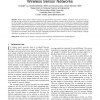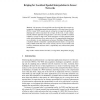244 search results - page 11 / 49 » Location-unaware coverage in wireless sensor networks |
TMC
2011
13 years 2 months ago
2011
—Mission-driven sensor networks usually have special lifetime requirements. However, the density of the sensors may not be large enough to satisfy the coverage requirement while ...
GLOBECOM
2009
IEEE
14 years 2 months ago
2009
IEEE
Abstract—The barrier coverage model was proposed for applications in which sensors are deployed for intrusion detection. In this paper, we study a strong barrier coverage problem...
SSDBM
2008
IEEE
14 years 1 months ago
2008
IEEE
Abstract. The presence of coverage holes can adversely affect the accurate representation of natural phenomena being monitored by a Wireless Sensor Network (WSN). Current WSN resea...
MOBIQUITOUS
2007
IEEE
14 years 1 months ago
2007
IEEE
An important objective of wireless sensor networks (WSNs) is to reliably sense data about the environment in which they are deployed. Reliability in WSNs has been widely studied in...
WINET
2011
13 years 2 months ago
2011
Sleep scheduling, which is putting some sensor nodes into sleep mode without harming network functionality, is a common method to reduce energy consumption in dense wireless sensor...


